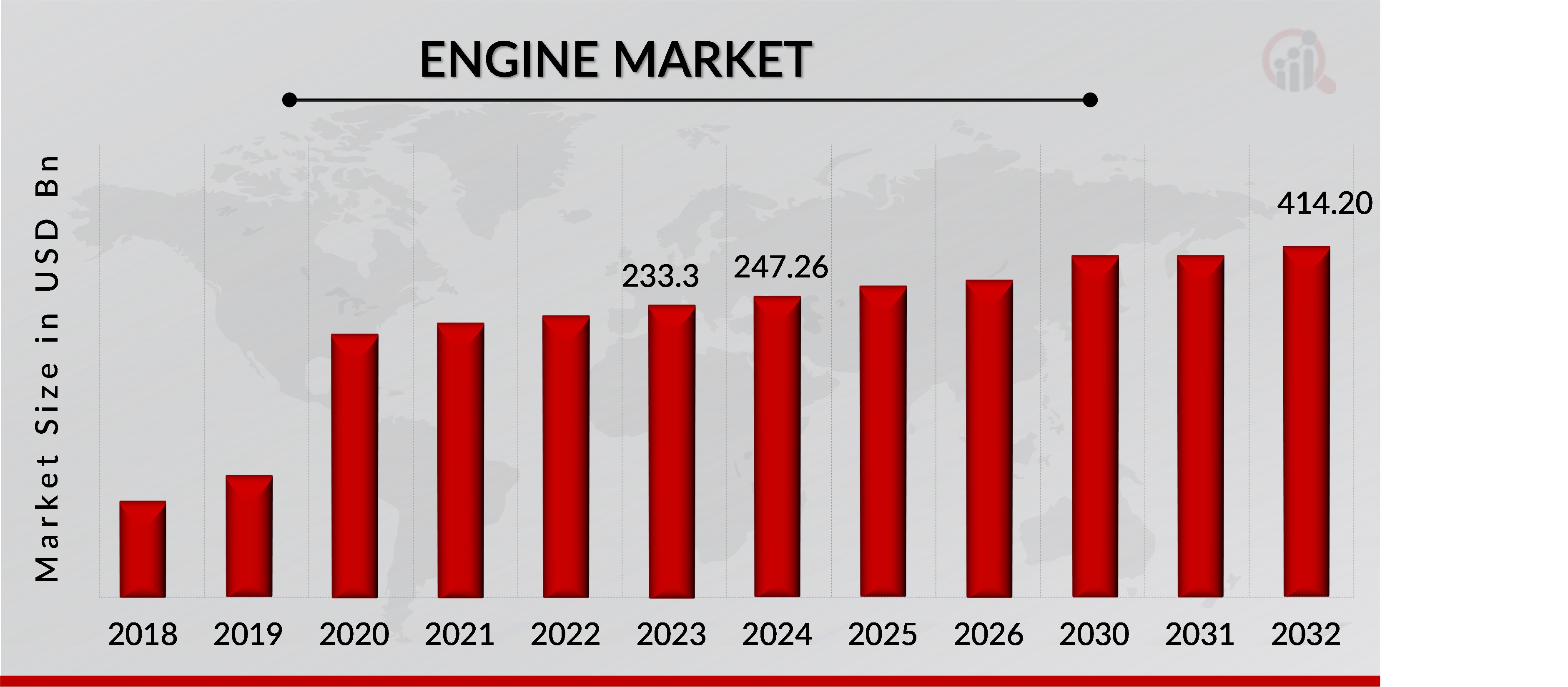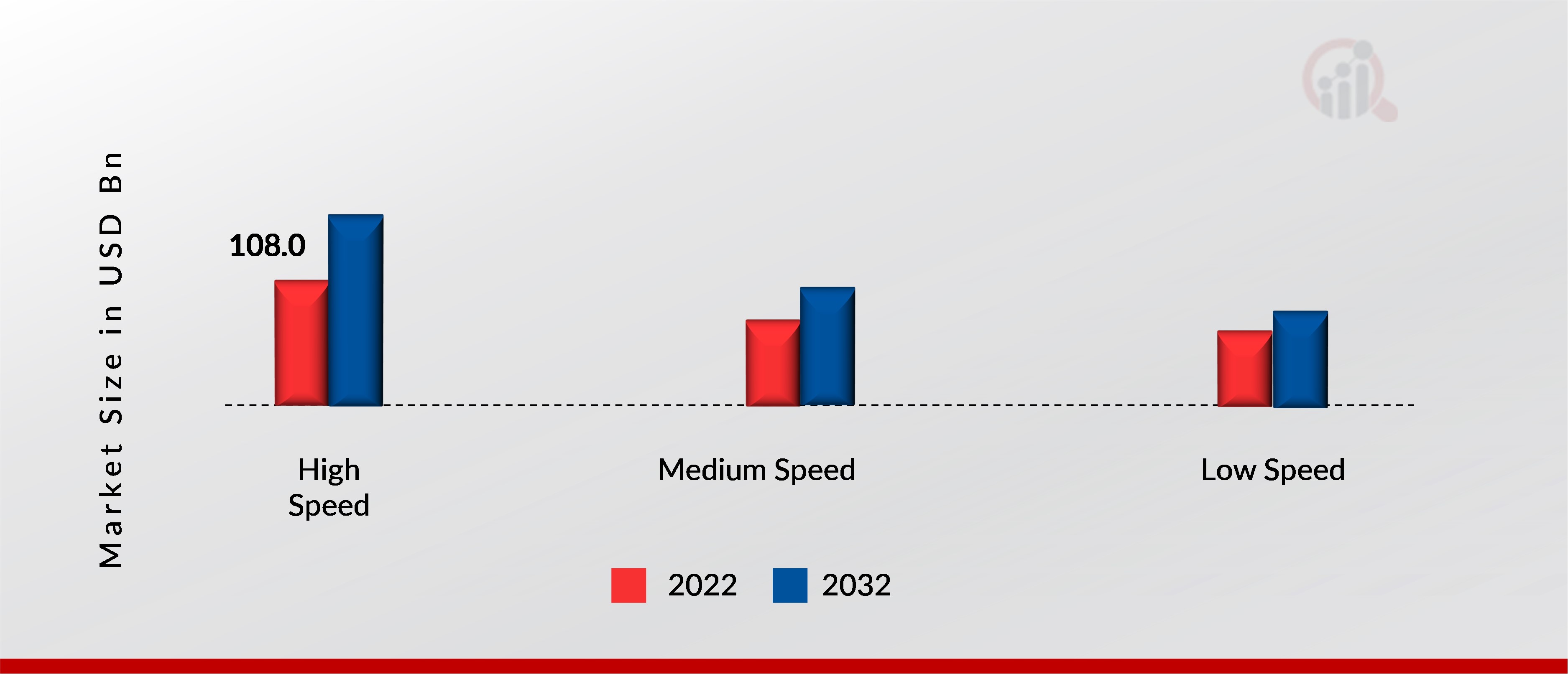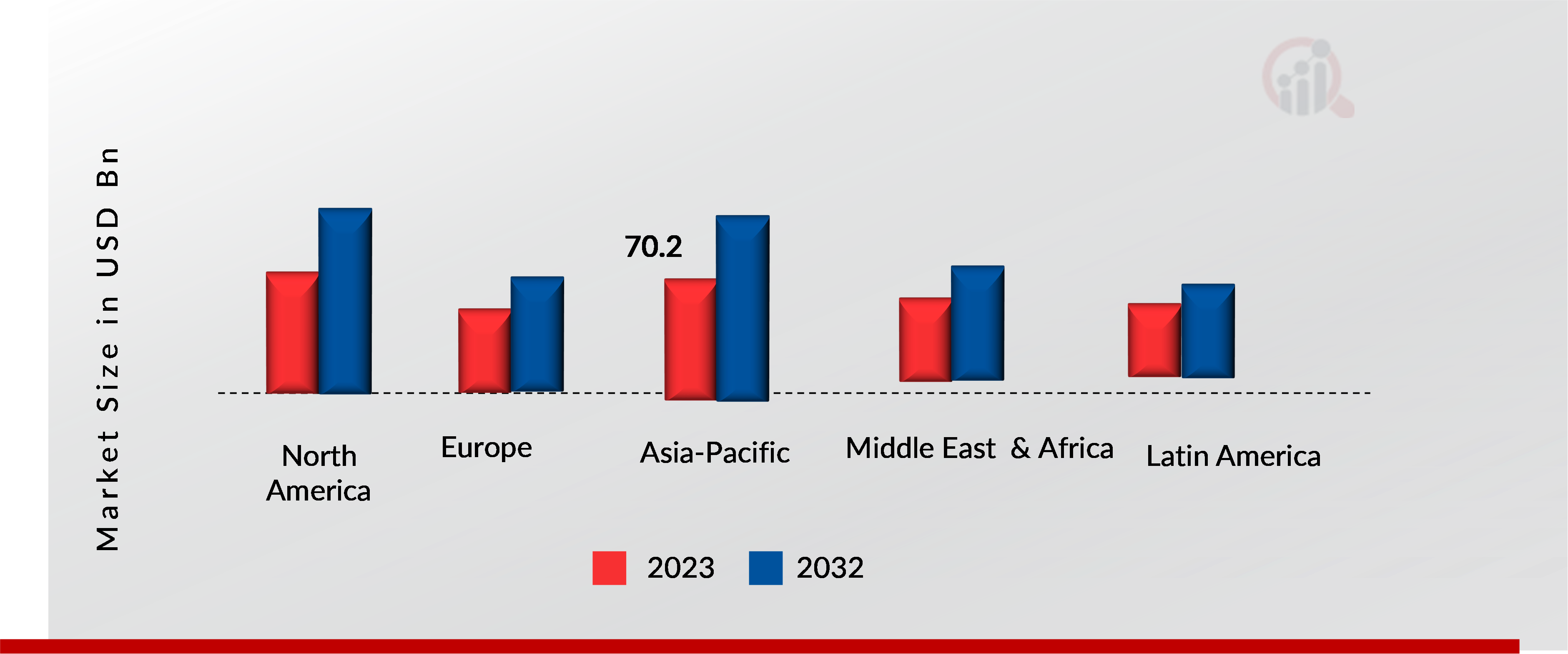Global Engine Market Overview
Engine Market Size was valued at USD 233.3 Billion in 2023. The Engine Market industry is projected to grow from USD 247.26 Billion in 2024 to USD 414.20 Billion by 2032, exhibiting a compound annual growth rate (CAGR) of 6.58% during the forecast period (2024 - 2032).
The engine provides the power or fuel any vehicle or machinery. It helps in providing the energy for propulsion or operation for doing the work. It is used in provide the efficiency, and reliability in the work. It converts various forms of energy, into mechanical energy. This conversion helps in the use of engines in various applications. The manufacturers are continuously making improvement in the engine, which has resulted in increasing the efficiency, increasing the productivity and saving time. The engines often feature advanced technologies, enhancing performance, reducing emissions, and promoting sustainability and making it suitable for use by the different industry and help in the growth of the engine market.
Fuel is burned inside the cylinders of an internal combustion engine to produce power. It functions by transforming fuel's chemical energy into mechanical energy. The piston is driven by compressed air and fuel in a standard four-stroke cycle, which is ignited by compression (in diesel engines) or a spark plug (in gasoline engines). In an internal combustion engine (ICE), the ignition and combustion of the fuel occurs within the engine itself. The engine then partially converts the energy from the combustion to work. The engine consists of a fixed cylinder and a moving piston. The expanding combustion gases push the piston, which in turn rotates the crankshaft. Ultimately, through a system of gears in the powertrain, this motion drives the vehicle’s wheels.
An external combustion engine burns fuel externally, or outside the engine. The burning fuel releases thermal energy, which is used to heat water and change it to steam. The pressure of the steam moves a piston back and forth inside a cylinder. The kinetic energy of the moving piston can be used to turn a vehicle’s wheels, a turbine, or other mechanical device. An external combustion engine (EC engine) is a reciprocating heat engine where a working fluid, contained internally, is heated by combustion in an external source, through the engine wall or a heat exchanger. The fluid then, by expanding and acting on the mechanism of the engine, produces motion and usable work. The fluid is then dumped (open cycle), or cooled, compressed and reused (closed cycle). In these types of engines, the combustion is primarily used as a heat source, and the engine can work equally well with other types of heat sources.

Source: Secondary Research, Primary Research, MRFR Database and Analyst Review
Engine Market Trends
INCREASING USE OF ENGINE IN LOCOMOTIVE
One of the important reason or factors of the growth in the engine market is the locomotive’s purpose. Railways uses diesel or electric engine. As populations is growing and people are focusing on urbanization, their arises the need for the good transportation system. Railways is providing an important source of transportation of the mass people, luggage and goods from one place to other. The development of the engine is creating the modern transportation infrastructure. At present there is lot of technological innovation is going on in the locomotive engines, which is helping in improving the speed, fuel consumption, efficiency. The engines are modernized in such a way that they that run for longer duration, speed can be easily controlled. They are also focusing on the integration of hybrid and electric propulsion systems has emerged as a game-changer, offering cleaner alternatives to traditional diesel engines and reducing greenhouse gas emissions.
Furthermore, the engine market in locomotives is being driven by the government and the authority, which has set out certain rules and regulations, in order to have smooth and comfortable running from one place to other. Governments are increasingly setting and framing the policies, with the focus at reducing or curbing pollution and decreasing the carbon footprints. To meet the regulations and the policies, the manufacturers of the engines are continuously focusing on the development of the engines, which is perfect and is in accordance to the regulation, this will help them to run without any interruption. The manufacturers are focusing on the engines, which is providing the good performance, increasing the efficiency, releasing less pollution and most important on the load capacity. The manufactures are promoting lot of research for the innovation in design so that it can take less space and can bear huge loads.
The growing demand for transporting goods and people, there is the demand for the need to expand the locomotive industry and making use of the powerful and reliable engines. Rapid urbanization and industrialization in countries are driving investments in rail infrastructure to facilitate the movement of goods and people efficiently. Due to which, the locomotive manufacturers are experiencing a surge in orders for new engines, which is increasing the need for the innovation and in standing ahead of competition in the engine market. Government is continuously providing the funding to the rail authority for the increasing and in developing of the infrastructure and the engine, to make the ride comfortable and reliable.
The company like Cummins, is providing the engines, at a lowest operating cost and are cleaner and more efficient to aid the rail industry’s journey towards a zero-carbon future. They are offering locomotive engine power, complete product ranges from 49- 4400 hp. It has the powerful product line with a high power-to-weight ratio, heavy duty design and high peak torque.
Engine Market Segment Insights
Engine by Speed Type Insights
The Engine Market segmentation, based on the speed type, the Engine Market has been bifurcated into high speed, medium speed and low speed. In 2022, the high-speed segment drove the Engine Market by holding a substantial market share. It is projected to register a CAGR of 6.64% during the projected timeframe. Typically, high-speed engines are engineered to operate at higher speeds and with greater power than regular ones. These engines are the beating heart of sports cars, racing cars, high-speed boats, racing vehicles and aircraft where performance is essential.
They achieve their impressive performance through a combination of lightweight components like aluminum and titanium, enabling swift revving; high compression ratios for improved efficiency and power; advanced cooling systems to manage the heat generated at high speeds; precision engineering to minimize friction and ensure smooth operation; optimized intake and exhaust systems for enhanced airflow and volumetric efficiency; advanced ignition systems for reliable ignition at high RPMs; and sophisticated electronic engine management systems for real-time optimization of various parameters. By combining all these elements, the result is an engine that represents the pinnacle of internal combustion technology, capable of producing power and efficiency in even the most challenging conditions.

Engine market Power Rating Insights
Based on the power rating, the Engine Market has been classified into Below 100 hp, 101-500hp, 501-1000hp and above 100hp. In 2023, the Below 100 hp segment drove the Engine Market by holding a substantial market share during the assessment period. This segment accounted for the largest share of the market in 2023 and is expected to remain dominant during the forecast period. Engines with less than 100 horsepower can be used in a variety of applications, particularly in compact cars meant for commuting and light work.
In the automotive industry, these engines power city cars and hybrids, providing plenty of power to navigate city streets while maintaining fuel efficiency. They also work well in small machinery such as generators, pumps and farm equipment, and their small size and power make them ideal for powering ancillary systems. Additionally, in emerging markets with limited infrastructure, these engines are driving innovation in affordable transportation solutions such as motorized rickshaws and small utility vehicles. Its capabilities extend to recreational vehicles such as motorcycles and ATVs, providing reliable performance for recreational and off-road adventures. Despite their low power, engines under 100 horsepower play an important role in meeting a variety of transportation and engineering requirements around the world.
Engine Market By Type Insights
Based on the Type, the Engine Market has been divided into Internal combustion engine, external combustion engine, rotary engine, Reciprocating engine, Air cooled engine and others. In 2023, the Internal Combustion Engine segment drove the Engine Market by holding a substantial market share during the assessment period. This segment accounted for the largest share of the market in 2023 and is expected to remain dominant during the forecast period. An internal combustion engine (excluding Reciprocating Engine, and Rotary Engine) is a type of heat engine in which the combustion of a fuel occurs with an oxidizer (usually air) in a combustion chamber that is an integral part of the working fluid flow circuit. In this type of engine, the expansion of the high-temperature and high-pressure gases produced by combustion applies direct force to some of the components of the engine.
This force is typically applied to components such as pistons, turbine blades, rotors, or a nozzle. They are subdivided into spark ignition, compression ignition, two-stroke and four-stroke engines. While these engines possess many stationary applications, most ICEs are used in mobile applications and are the primary power supply for vehicles such as cars, aircraft and boats and are powered by petroleum-based fuels like natural gas, gasoline, diesel fuel, or biofuels like ethanol, biodiesel, hydrogen and others.
Engine market By End user Insights
Based on the End user, the Engine Market has been divided into Power Generation, Marines, Locomotives, Mining, Oil & Gas, Construction and others. In 2023, the Power Generation segment drove the Engine Market by holding a substantial market share during the assessment period. This segment accounted for the largest share of the market in 2023 and is expected to remain dominant during the forecast period. Power plants are built in many different forms, powered by nuclear, wind, solar, ocean tides, natural gas, coal, and other fuels. Many use turbines to power generators that provide electricity, but internal combustion engines also play a big part in providing alternative means of power. Plants may group several internal combustion engines together into blocks and use these exclusively to generate power. Electric generators powered by internal combustion engines are an available, affordable, and proven means to maintain electric power.
These systems can utilize a number of fuel types, including both liquid and gaseous fuels. Smaller homeowner-sized and portable generators are typically powered by gasoline and propane. Larger units are typically powered by natural gas and diesel. Internal combustion engines are often used in power stations as backup power sources, continuing to provide electricity in case of a grid outage or other emergency. Diesel engines are ideal in such situations. They’re relatively cheap when it comes to price per kW, power-dense in terms of kW/volume and weight, and both simple and reliable. They’re also dynamic when it comes to load response, capable of providing backup power to critical systems such as hospitals, data centers, and other essential services in the least amount of time. Engines used for peaking power are typically larger than those used for generating backup power and can be clustered together to provide more power.
Engine Market Regional Insights
Based on Region, the Engine market is segmented into North America, Europe, Asia-Pacific, Middle East & Africa, and Latin America. The Asia-Pacific Engine market held the maximum market share and is also expected to account for the significant revenue share during the forecast period. The automotive industry in Asia Pacific is a fast-growing market that is driven by industrialization, urbanization and technological advancement. Countries like China, Japan, India, and South Korea are responsible for leading the development of diverse engineering, manufacturing & industrial sectors in the region, which contributes to the demand for engines in various applications.
The automotive industry is witnessing a surge in demand for passenger cars, commercial vehicles, and motorcycles due to the rising urbanization. Moreover, the region's robust manufacturing sector requires engines to power machinery and equipment across industries such as construction, agriculture, and mining. In addition, the region's energy-intensive manufacturing sector needs mechanical power and equipment in industries such as construction, agriculture and mining. Also, the growing interest in sustainable development and environmental standards, along with the increasing demand for electric and hybrid engines, is driving investment and innovation in alternative manufacturing technologies. As a result, the Asia-Pacific automotive market offers many opportunities for manufacturers and suppliers and is expected to continue to grow and innovate in the future.

Engine Market Players & Competitive Insights
Engine Market is characterized by a high level of competition, with many players emerging for market share. The top 10 companies in the market account for a significant market share of the Engine Market. The Engine Market is characterized by a high level of competition, with many players emerging for market share. The competitive landscape of the engine market is dynamic, with companies constantly innovating and expanding their product offerings. Despite the challenges, there are several factors that are driving growth in the Engine Market such rapid urbanization in developing countries boosts market growth as well as the automotive industry's evolution toward electrification and hybridization. The Engine Market is expected to witness significant growth in the coming years, owing to growth in hybrid power generation in rural and remote locations.
The market is benefiting from the development of new technologies. The key players in the Engine Market include General Motors Company, Wartsila, AGCO Corporation, Ford Motor Company, Caterpillar Inc, Deere & Company, Mitsubishi Heavy Industries, China FAW Group Co., Ltd., Cummins Inc. and Detroit Diesel Corporation. These companies compete on the basis of product quality, innovation, price, customer service, and market share. Companies also engage in various strategic initiatives, such as mergers and acquisitions, partnerships, joint ventures, expansions, and investments, to enhance their market position and expand their product portfolio.
Companies are also focusing on developing new and innovative products that meet the specific needs of their customers. Companies will need to continue to innovate and expand their product offerings to remain competitive. For instance, on 15 November 2023, Technology group Wartsila introduced the marine sector’s first commercially available 4-stroke engine-based solution for ammonia fuel. The new solution enables a significant advance in sustainable shipping operations – during a time in which ship owners are seeking viable options among green fuels. The ammonia solution is now commercially available as part of the Wartsila 25 engine platform.
Key Companies in the Engine Market includes
- General Motors Company
- Wartsila
- AGCO Corporation
- Ford Motor Company
- Caterpillar Inc
- Deere & Company
- Mitsubishi Heavy Industries
- China FAW Group Co., Ltd.
- Cummins Inc.
- Detroit Diesel Corporation
Engine Market Segmentation:
Engine Market speed Type Outlook
- High Speed
- Medium Speed
- Low Speed
Engine Market Power Rating Outlook
- Below 100 hp
- 101-500 hp
- 501-1000 hp
- Above 1000 hp
Engine Market Type Outlook
- Internal Combustion Engine
- External Combustion Engine
- Reciprocating Engine
- Rotary Engine
- Air Cooled Engines
- Others
Engine Market Type Outlook
- Power Generation
- Marines
- Locomotives
- Mining
- Oil & Gas
- Construction
- Others
Engine Market Regional Outlook
- North America
- Europe
- Germany
- UK
- France
- Spain
- Italy
- Russia
- Rest of Europe
- Asia-Pacific
- China
- Japan
- India
- South Korea
- Rest of Asia-Pacific
- Latin America
- Brazil
- Mexico
- Argentina
- Rest of Latin America
- Middle East & Africa
- GCC Countries
- South Africa
- Rest of Middle East & Africa
| Report Attribute/Metric |
Details |
| Market Size 2023 |
USD 233.3 Billion |
| Market Size 2024 |
USD 247.26 Billion |
| Market Size 2032 |
USD 414.20 Billion |
| Compound Annual Growth Rate (CAGR) |
6.58% (2024-2032) |
| Base Year |
2023 |
| Forecast Period |
2024-2032 |
| Historical Data |
2018 to 2022 |
| Forecast Units |
Value (USD Million) |
| Report Coverage |
Revenue Forecast, Competitive Landscape, Growth Factors, and Trends |
| Segments Covered |
Speed Type, Power Rating, Types, End User, and Region |
| Geographies Covered |
North America, Europe, Asia Pacific, south America, middle east & Africa |
| Countries Covered |
US, Canada, Germany, UK, France, Spain, Italy, Russia, China, Japan, India, South Korea, Brazil, Mexico, Argentina, South Africa, GCC countries |
| Key Companies Profiled |
General Motors Company, Wartsila, AGCO Corporation, Ford Motor Company, Caterpillar Inc, Deere & Company, Mitsubishi Heavy Industries, China FAW Group Co., Ltd., Cummins Inc. and Detroit Diesel Corporation |
| Key Market Opportunities |
Increasing Of Engine By The Various End Use Industry |
| Key Market Dynamics |
Increasing Use Of Engine In Locomotive Increasing Use Of Engine In Power Generation |
Frequently Asked Questions (FAQ) :
Engine Market Size USD 414.20 Million by 2032
Growth rate of the Engine Market is 6.58% by 2032
Asia Pacific held the largest market share in the Engine Market.
General Motors Company, Wartsila, AGCO Corporation, Ford Motor Company, Caterpillar Inc, Deere & Company, Mitsubishi Heavy Industries, China FAW Group Co., Ltd., Cummins Inc. and Detroit Diesel Corporation
Internal Combustion Engine Type had the largest market share Engine Market.

















